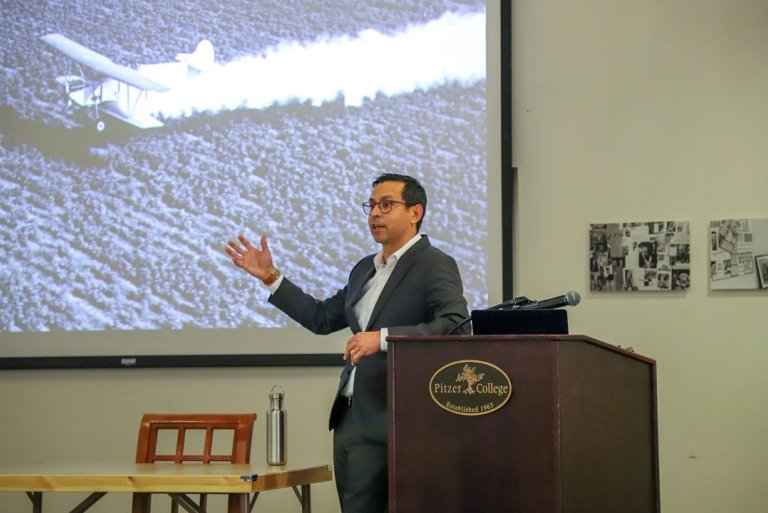Talk Highlights Unsettling Connections Between Toxic Waste and Food
For the fall lecture series “Talking Trash,” Pitzer’s Munroe Center for Social Inquiry invites Adam M. Romero to discuss how industrial waste affects agriculture.

Everyone wants to get rid of toxic waste, right?
Wrong.
For Adam M. Romero, there’s one sector that needs toxic waste to survive: the agricultural industry.
“Agriculture needs toxicity to function,” said Romero, an associate professor of science, technology, and society at the University of Washington Bothell. He addressed a student audience last week during the latest lecture in “Talking Trash,” this season’s lecture series sponsored by the Munroe Center for Social Inquiry (MCSI).
The center is named in honor of Ruth and Lee Munroe, two former Pitzer professors who were beloved members of the College community and embodied in their lives and service a pursuit of interdisciplinary learning and public inquiry. Each academic year the MCSI presents a lecture series modeled on these qualities.
Romero’s talk, “Waste and Surplus in the History of American Agriculture,” provided numerous startling, provocative revelations as he outlined the unlikely connection between industrial waste and the production of food in the U.S. and abroad.
Arsenic, for example, is produced during the smelting of ores for copper, lead, cobalt, and gold. Romero explained how arsenic became the basis of the pesticides that farmers started using in the early 20th century.
This usage along with the creation of chemical fertilizers became so successful in the early 20th century that they resulted in another kind of waste: an oversupply of food. Overproduction hurt farmers then, and its impact continues today.
“What good does it do to triple your production if it’s adding excess to the market and lowering prices?” Romero asked. “If you listen to typical farmers, they’ll tell you that they feel trapped in these systems, in debt, and don’t know what to do.”

In his recent book Economic Poisoning Industrial Waste and the Chemicalization of American Agriculture, Romero describes a vicious cycle of factors that have complicated the situations for industries in the U.S. and abroad. Romero’s talk provided an overview of this research as well as looking at how other forms of industrial waste—especially petroleum byproducts—have crept into consumer products over the years.
Their presence is so pervasive, in fact, that he said “it’s hard to imagine a world before petrochemicals.”
MCSI Director Jesse Lerner said the goal of this fall’s MCSI lecture series is to shed light on how society responds to trash and waste and how this aspect of modern life is critically overlooked.
“The series addresses the topic of garbage from a variety of disciplinary perspectives. We’ll be hearing from a range of accomplished scholars, from fields including geography, environmental history, anthropology, and science, technology and society (to name a few), all of whom research and write about what happens to the things we throw away,” Lerner said. “From the Great Pacific Garbage Patch to the history of Fresh Kills, this exciting series of public talks addresses a pressing issue in which we are all implicated and responsible.”
Visit here for more information the next lecture on October 1.
News Information
Published
Author
Nick Owchar
Organization
- Munroe Center for Social Inquiry (MCSI)


